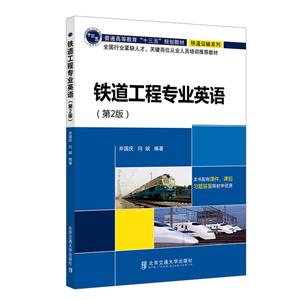第1部分 专业阅读
LESSON 1 IntrOduction
1.1 Early Beginning
1.2 Development and Diversification
1.3 The Customer
1.4 The Operator
1.5 Overall Planning
1.6 Choice ofRoute andLevel
1.7 Resources Required
LESSON 2 Station Layout
2.1 The Customer and the Design Process
2.2 The Need for Standards
2.3 The Objectives in Station Planning
2.4 The Concept ofSpeed and Flow
2.5 The Consideration ofTime
2.6 Planning forNormal Operation
2.7 CapacityRequirements
2.8 TicketHalls
2.9 Access and Interchange
LESSON 3 Rail profile
3.1 FunctionofRails
3.2 Types ofRails
3.3 Requirements for an Ideal Rail Section
3.4 RailWear
3.5 Rail Manufacture
LESSON 4 Wheel.Rail Interaetion
4.1 Introduction
4.2 Wheel.Rail Guidance
4.3 Wheelset andTrackDimensions
4.4 Conicity
4.5 W101TIWheel Profiles
4.6 Wheel—Rail Contact Stresses
LESSON 5 Rolling Stock
5.1 The Range ofRailway Rolling Stock
5.2 Steam Motive Power
5.3 Diesel Traction
5.4 Electric Traction
5.5 Evolution ofWheel Layout
5.6 Freight Rolling Stock
5.7 Specialized Engineering Rolling Stock
5.8 Manufacturing Methods
LESSON 6 Depots and Workshops
6.1 Proper Maintenance ofRolling Stock
6.2 Rolling Stock Maintenance Considerations
6.3 Establishing a Maintenance Regime
6.4 Maintenance Management
6.5 Balance between Workshops and Depots
6.6 Depot SiRing
6.7 TheNeeds ofthe Maintainer
6.8 Basic Requirements forDepots
LESSON 7 Curves and Gradients
7.1 General Considerations
7.2 Curvature and Superelevation in Horizontal Curves
7.3 Superelevation
7.4 Transition Curves
LESSON 8 Track Components
8.1 Basic Components OfTrack
8.2 TrackBallast
8.3 Development ofBallastless Track
8.4 SleeperFunctions
8.5 Timber Sleepers
8.6 Rail Fastenings.Base Plates and Pads
8.7 Points.Switches and Crossings
8.8 Points orTurnouts
LESSON 9 Track Design
9.1 TrackLpads
9.2 StaticTrackDesigns
9.3 DynamicTrackDesign
LESSON 10 Switch and Turnout
10.1 Introduction ofTumout
10.2 The StandardTumout
10.3 Geometry ofthe Turnout
LESSON 11 Bridges and Structures
11.1 ReinforcedConcrete Structures
11.2 PrestressedConcrete
11.3 Brick andMasonry Structures
11.4 Structural Maintenance
LESSON 12 Tunnels and Tunneling
12.1 The History ofTunneling
12.2 Cu and Cover Tunnels
12.3 ModeruTunnel Shields
12.4 Differing Ground Conditions
12.5 Construction Methods
12.6 Tunnel Linings
12.7 Vertical and Sloping Shafts
12.8 Size and Shape ofaTunneI
12.9 Tunnel Inspection and Maintenance
12.10 Safety inTunnel Construction
LESSON 13 LGV(HSRl Construction
13.1 Introduction
13.2 Preparing the Trackbed
13.3 LayingtheTrack
13.4 JoiningTrackSections
13.5 Adding Ballast
13.6 Finishing Construction
LESSON 14 Testing and Acceptance
14.1 Introduction
14.2 ComponentTesting andAcceptance
LESSON 15 Earthworks.Drainage and Fencing
15.1 StabilitV ofEarthworks
15.2 ShortTerill Considerations
15.3 Long TerlTl Considerations
15.4 Slips
15.5 Detection ofMovement ofEarthworks
15.6 Dealing with Embankment Slips
15.7 Dealing with Cutting Slips
LESSON 16 Noise and Vibration
16.1 Introduction
16.2 Some Definitions
16.3 Vibration Reduction
第2部分图解铁道工程
1.Locomotive
2.Rail Profile
3.Rail Fastening System
4.Railway Sleeper
5.Ballast
6.Rail Joints
7.Ballastless/Nonballasted Track
8.Track Geometry
9.Turnout and Crossings
10.Railway Damage
11.Rail Machine
12.Station Layout
13.RailwayYard
14.Railway Platform
15.Railway Bridge
16.RailwayTunnel
17.Vibration
18.TrackMonitoring Systems
第3部分专业词汇
附录A常用铁道工程网站
参考文献





















